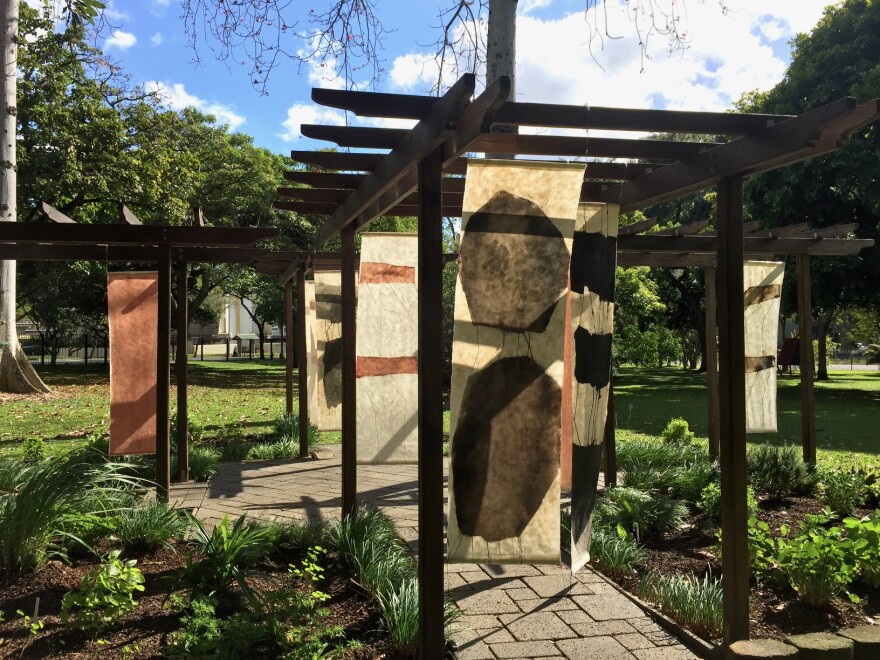Across Honolulu, storefront galleries have been disappearing, and exhibition venues are becoming rare, but you’re more likely to see art on the street or in a bar. With changes underway in Honolulu’s arts infrastructure, the role of the City could be crucial.

Update on the Arts at Marks Garage: Events are being scheduled through the end of December, potential new partners are appearing, and leadership openings remain. Looking for a $50,000 donor to get the Theatre named after them. Mid November remains the time by which a decision must be made to call it quits or soldier on.
Did you know that like the state, Honolulu has an Art in Public Places law that sets aside 1% of the cost of new county building projects for acquiring art? Honolulu Deputy Managing Director Georgette Deemer says, that’s a strong statement.

“It serves to make sure Hawai‘i artists are supported but it also is an opportunity for the public to see that art is part of our infrastructure.”
A select number of artists are fortunate to win County commissions. Deemer says art is integrated into two new City projects across O‘ahu, the Hau‘ula Fire Station and the Joint Traffic Management Center with the swooping chrome exterior at South and King Streets.
“What’s great about Hawai‘i is that we don’t just have Western type performing arts,” says City Managing Director Roy Amemiya. “We also have a whole host culture that has hula and various instruments you don’t see elsewhere. We also have Asian troupes coming in from time to time, so we’re lucky in that regard. It’s not just opera or the symphony.”
Amemiya points to the sculpture on the traffic island at the intersection of Kapi‘olani and King, it depicts a fisherman repairing his nets. The City has recently restored water flow, just in time for the reindeer which show up at Christmas. Small victories count, says Amemiya, because money for art?

“It’s always a challenge, trying to keep afloat. Part of that is also because we have a rich cultural aspect to Hawai‘i where there is a competition for dollars.”
Not every town in America demands Parks and Rec classes in hula, tai chi, Okinawan dance, bonsai, ‘ukulele and zumba-- beloved City and County culture programs like these reach deep into neighborhoods. And the results often show up on display in Honolulu Hale.
Did you know Honolulu has an official Arts district? It’s just over 12 blocks, between Bethel and Smith Streets and from Nimitz to Beretania Street. But where’s the art? Sandy Pohl, owner of Louis Pohl Gallery recently opened the Downtown Art Center in the City’s Chinatown Gateway Plaza, the pink building at Nu‘uanu and Hotel. The new Satellite City Hall opened in the building a couple of months ago, bringing the possibility of more foot traffic.

To activate the new art space, Pohl is turning to Barbara Rau, former manager of The Contemporary Museum Gift Shop. Rau is looking to create a high quality art and craft store along the lines of Following Sea, a popular art purveyor in K?hala Mall for many years. Pohl runs make-and-take art classes that could bring office workers into the space for projects.
As for whether this is good for the City, Amemiya says, “It all comes down to being able to pay their rent and the maintenance. We’re hoping she does well.”
There’s a huge empty space, over ten thousand square feet, on the second floor which has been empty for years. Pohl and the Honolulu Printmakers have submitted bids that the City says do not cover both maintenance and space rental costs. Unlike for-profit entities, the City isn’t ready to invest in seeding the neighborhood the way Kaka‘ako was primed for development with sponsored art events and subsidized rents. Arguably, the City Administration would need political cover to say, We’ll lose money on these rents, but get some activity going, and see what that could do for Chinatown and the whole downtown area.

Right now, the city has seven available properties in Chinatown, at low market rates, ranging from 300 to 13 thousand square feet.
“To be very honest, throughout Chinatown, we’re looking for tenants that will activate the space. Because the more active the space is, the less likely it is that people are going to loiter. So we are looking for people who can bring people to the space.”
Amemiya says the City is relocating River of Life Mission to Iwilei in the next year or so, and has outlawed cardboard boxes of trash on the sidewalks. “There are certain good things happening, American Savings coming in, rail coming in, which will make it easier to get in and out of an area that can get congested pretty quickly. Part of the reason we’re doing bulb outs and other things is to prepare for when rail comes in and we need to have multi modal transportation, not just the car we’ve grown up with.”

Transit Oriented Development for a rail stop at Kekaulike street will mean an infusion of planning and funds on the ‘Ewa end of Chinatown in the next 5 years. The Honolulu Rail project is slated to be active at Ala Moana by early 2026.
Deemer is encouraged by the State’s Creative Industries division, and the way they have concentrated on certain areas, like film, fashion, and music. Deemer says state/county partnerships could stretch dollars and lift the state’s arts profile.
“We saw it when we combined forces with state and counties for film production. The critical mass of pooling marketing funds and going jointly to market yourself as a unified state and City. That was really powerful. I see that with potential for art as well.”




